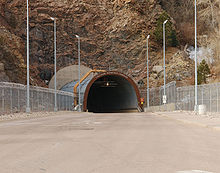
Back Búnker AN ملجأ Arabic ܒܝܬ ܓܘܣܐ ARC Sığınaq Azerbaijani Бункер Bulgarian Bunker Breton Bunker BS Búnquer Catalan پەناگە CKB Bunker Danish
This section needs additional citations for verification. (March 2022) |


A bunker is a defensive military fortification designed to protect people and valued materials from falling bombs, artillery, or other attacks. Bunkers are almost always underground, in contrast to blockhouses which are mostly above ground.[1] They were used extensively in World War I, World War II, and the Cold War for weapons facilities, command and control centers, and storage facilities. Bunkers can also be used as protection from tornadoes.
Trench bunkers are small concrete structures, partly dug into the ground. Many artillery installations, especially for coastal artillery, have historically been protected by extensive bunker systems. Typical industrial bunkers include mining sites, food storage areas, dumps for materials, data storage, and sometimes living quarters. When a house is purpose-built with a bunker, the normal location is a reinforced below-ground bathroom with fiber-reinforced plastic shells. Bunkers deflect the blast wave from nearby explosions to prevent ear and internal injuries to people sheltering in the bunker. Nuclear bunkers must also cope with the underpressure that lasts for several seconds after the shock wave passes, and block radiation.
A bunker's door must be at least as strong as the walls. In bunkers inhabited for prolonged periods, large amounts of ventilation or air conditioning must be provided. Bunkers can be destroyed with powerful explosives and bunker-busting warheads.
- ^ For the difference between bunkers and blockhouses see Schneider & Kitchen 2002, p. 87, BACM Research 2009, p. 263, Davis 2007, p. 290